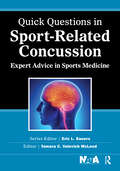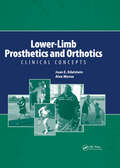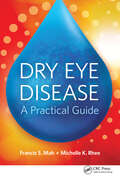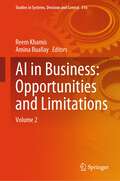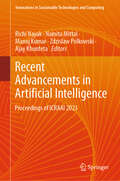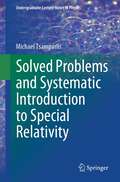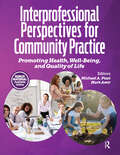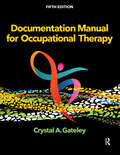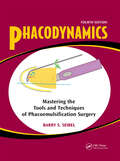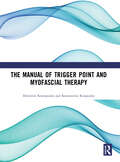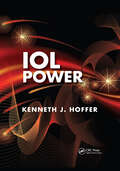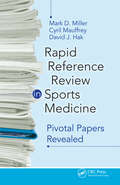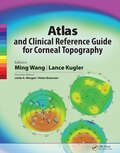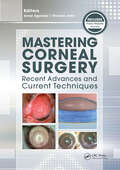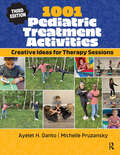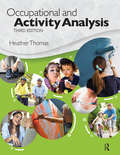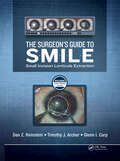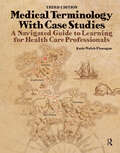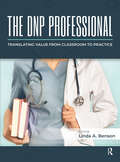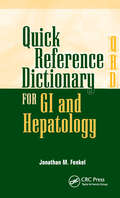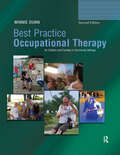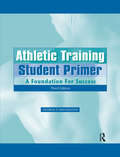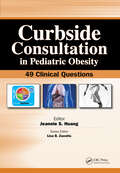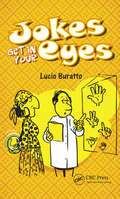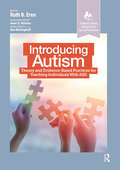- Table View
- List View
Quick Questions in Sport-Related Concussion: Expert Advice in Sports Medicine (Quick Questions in Sports Medicine)
by Tamara McLeodAre you looking for concise, practical answers to questions that are often left unanswered by traditional sports medicine references? Are you seeking brief, up-to-date, expert advice for common issues that can be encountered when working with athletes?Quick Questions in Sport-Related Concussion: Expert Advice in Sports Medicine provides a unique format of concise and to the point responses with clinical application, backed by the latest research on sport-related concussions among athletes. Dr. Tamara C. Valovich McLeod and her contributors present 39 common clinical questions and answers based on the author’s experience and the many different guidelines, consensus, and position statements that have garnered increased attention in the media and literature. Co-published with the National Athletic Trainers’ Association, Quick Questions in Sport-Related Concussion: Expert Advice in Sports Medicine provides concise answers to 39 frequently asked clinical questions. Written in a conversational tone, the authors of the individual questions represent a variety of different backgrounds and are experts in their respective field. The variety of questions and brevity of responses will make this a book that is easy to read and reference at the point of care.Some sample sections and questions include: Concussion BasicsWhat are the best educational materials available to help a coach, parent, or athlete learn about concussions? Pre-Season PlanningWhat are the most important regulations and policies to consider regarding the management of sport-related concussion? Concussion assessmentHow common are vestibular deficits following sport-related concussion and what tools are best used to assess vestibular function? Concussion management considerationAre there any rehabilitation exercises you can do to help a concussed athlete heal faster? Return to activityWhat is the role of the graded exertion protocols for making RTP decisions? Return to schoolWhat is cognitive rest and can it help recovery following concussion? Quick Questions in Sport-Related Concussion: Expert Advice in Sports Medicine is the perfect at-your-side resource for the athletic trainer, team physician, or sports medicine clinician looking for practical answers to sport-related concussion questions. The concise and conversational tone allows the reader to readily apply the information into their everyday practice.
Lower-Limb Prosthetics and Orthotics: Clinical Concepts
by Joan Edelstein Akex MorozLower-Limb Prosthetics and Orthotics: Clinical Conceptsis a comprehensive overview of lower-limb prosthetics and orthotics, covering normal and pathological gait, lower-limb biomechanics, clinical applications, as well as prosthetic and orthotic designs and components. Joan Edelstein and Alex Moroz have writtenLower-Limb Prosthetics and Orthotics with the clinician’s perspective in mind. Clinical management is incorporated throughout the text, including basic surgical concepts, postoperative management, preprosthetic care, and training in the use of devices. Additionally, this text incorporates unique features relevant to physicians such as prescription writing and prosthetic and orthotic construction and modification, as well as, the latest research regarding energy consumption and long-term utilization of prostheses.Chapters Include: Orthotics in neuromuscular diseases Orthotics in pediatrics Functional expectations Gait and activities training Transtibial and transfemoral prostheses and components Transtibial and transfemoral biomechanics, evaluation, and gait analysis Disarticulations and Bilateral Amputations With over 150 line drawings and photographs to supplement the text, Lower-Limb Prosthetics and Orthotics: Clinical Concepts is ideal for clinicians in the fields of physical medicine and rehabilitation, orthopedics, vascular surgery, physical therapy and occupational therapy.
Dry Eye Disease: A Practical Guide
by Michelle Rhee Francis MahDue to the growing population of dry eye patients, there has been much study of dry eye disease. Following the full reports of the International Dry Eye Workshops of 2007 and 2017 (DEWS I and II), as well as the recent Dry Eye Assessment and Management (DREAM) trial, there is a growing body of consensus and evidence-based literature on the treatment of dry eye. Dry Eye Disease: A Practical Guide synthesizes all these scientific sources into a comprehensive, yet, user-friendly clinical reference. From epidemiology and pathogenesis, to disease subgroups, diagnostics, and management, Drs. Francis Mah and Michelle Rhee with their team of over 35 renowned contributors have distilled all the latest information on dry eye disease into an easily digestible guide. Featuring diverse case scenarios pulled from clinical practice, Dry Eye Disease engages the reader and encourages critical thinking to apply current understanding of dry eye disease to the office and operating room. All aspects of this complex disease are discussed, including the relationship between dry eye and surgical outcomes and contact lens wear. Some topics include: The latest biomarker diagnostics Meibomian gland dysfunction therapeutic technologies The role of integrative medicine Advances in therapeutic contact lenses Ophthalmologists and optometrists of all specialties and skill levels will find Dry Eye Disease: A Practical Guide a comprehensive yet practical clinical guide for treating the growing population of dry eye patients.
AI in Business: Volume 2 (Studies in Systems, Decision and Control #516)
by Reem Khamis Amina BuallayThis book is a comprehensive guide to understanding the potential of artificial intelligence (AI) in improving business functions, as well as the limitations and challenges that come with its implementation. In this book, readers will learn about the various opportunities that AI presents in business, including how it can automate routine tasks, reduce errors, and increase efficiency. The book covers a range of topics, including how AI can be used in financial reporting, auditing, fraud detection, and tax preparation. However, the book also explores the limitations of AI in business, such as the need for skilled professionals, data quality, and the potential for bias. It examines the challenges that companies face when implementing AI in business functions, including the need for ethical considerations, transparency, and accountability. The book is written for business professionals, business leaders, and anyone interested in the potential of AI in business functions. It offers practical advice on how to implement AI effectively and provides insights into the latest developments in AI technology. Through case studies and real-world examples, readers will gain a deeper understanding of how AI can be used to enhance business functions, as well as the potential pitfalls and limitations to be aware of. Overall, this book is an essential guide for anyone looking to harness the power of AI to improve their business functions and to stay ahead in an increasingly competitive business environment.
Recent Advancements in Artificial Intelligence: Proceedings of ICRAAI 2023 (Innovations in Sustainable Technologies and Computing)
by Manoj Kumar Namita Mittal Zdzislaw Polkowski Richi Nayak Ajay KhuntetaThis book features research papers presented at the Second International Conference on Recent Advancements in Artificial Intelligence (ICRAAI 2023), held at Poornima University, Jaipur, India during 15 – 16 December 2023. The book presents original research work in the areas of computational intelligence, artificial intelligence, machine learning, data science and data analytics, cloud computing, and internet of things. The book is beneficial for readers from both academia and industry.
Solved Problems and Systematic Introduction to Special Relativity (Undergraduate Lecture Notes in Physics)
by Michael TsamparlisIn most undergraduate physics classes Special Relativity is taught from a simplistic point of view using Newtonian concepts rather than the relativistic way of thinking. This results in students often finding it difficult to understand properly the new approach/new ideas, and consequently to solve relativistic problems. Furthermore, a number of books treat the theory using advanced mathematics which is not necessary for the first approach to the theory. This book is intended to serve two roles: a. To treat a student in a systematic constructive way to the basic structure of the theory and b. To provide a large number of solved in-detail problems in the kinematics and dynamics of Special Relativity. Concerning the first aim the book introduces the basics of four-dimensional mathematics, i.e., Lorentz metric, relativistic tensors, and prepares, through working examples, the transition to General Relativity, which requires, besides the relativistic concepts, the use of Differential Geometry and tensor analysis. The presentation is concise and does not replace a book on Special Relativity. Concerning the second intention the large number of problems provides the necessary material which can be used in order to familiarize the student with the relativistic “world”. These problems can be used in the class by the teachers either as working examples or as problem sheets. It will be our pleasure if the book will be useful to both students and teachers.
Interprofessional Perspectives for Community Practice: Promoting Health, Well-Being, and Quality of Life
by Michael Pizzi Mark AmirNow more than ever health care professionals play an increased role in the promotion of health to populations. Unique and innovative, Interprofessional Perspectives for Community Practice: Promoting Health, Well-being and Quality of Life weaves everyday care into prevention, community, and population health, creating a new and more expansive vision of health for all without compromising traditional practices.Authors and editors Drs. Pizzi and Amir discuss and illustrate a client-centered preventive and health, well-being and quality of life approach rooted in best practice principles from interprofessional literature and firsthand experience. The text illustrates how allied health professionals implement those principles in their everyday and traditional practices with an emphasis on exploring health and well-being issues. Interprofessional Perspectives for Community Practice provides detailed guidance in program development and implementation.What’s included in Interprofessional Perspectives for Community: Clinical anecdotes on successful community practices A focus on primary and secondary prevention Assessments, interventions, and community practice examples Descriptions of community-based practice settings such as adult day care, independent living programs, hospice, and home health care Health and wellness across the lifespan Bonus chapters available online as PDFs for readers The first text of its kind to weave interprofessionalism, community practice, and health, well-being, and quality of life, Interprofessional Perspectives for Community Practice: Promoting Health, Well-being and Quality of Life is for all health care workers and students who wish to transfer practice skills from the clinical setting to a population-based program development model.
Documentation Manual for Occupational Therapy
by Crystal GateleyThe best-selling, newly updated occupational therapy textbook Documentation Manual for Occupational Therapy, Fifth Edition, is made for students and early-career practitioners learning the critical skill of documentation. The workbook format offers students ample opportunities to practice writing occupation-based problem statements and goals, intervention plans, SOAP notes, and other forms of documentation. The Fifth Edition has also been updated to reflect changes in the American Occupational Therapy Association’s Occupational Therapy Practice Framework: Domain and Process, Fourth Edition. What’s included in Documentation Manual for Occupational Therapy:• Numerous worksheets for students to practice individual skills with suggested answers provided in the Appendix• Updated information on coding, billing, and reimbursement to reflect recent Medicare changes, particularly in post–acute care settings• Examples from a variety of contemporary occupational therapy practice settings Included with the text are online supplemental materials for faculty use in the classroom. Instructors in educational settings can visit the site for an Instructor’s Manual with resources to develop an entire course on professional documentation or to use the textbook across several courses. One of the most critical skills that occupational therapy practitioners must learn is effective documentation to guide client care, communicate with colleagues, and maximize reimbursement. The newly updated and expanded Documentation Manual for Occupational Therapy, Fifth Edition, will help students master their documentation skills before they ever step foot into practice.
Phacodynamics: Mastering the Tools and Techniques of Phacoemulsification Surgery
by Barry S. SeibelWhat surgical advancements have spawned from the evolution of phaco technology? Join the thousands of surgeons who have utilized Phacodynamics: Mastering the Tools and Techniques of Phacoemulsification Surgery to understand and benefit from the advantages of phaco technology. The revised, expanded, and updated Fourth Edition of this classic text includes over 300 simple, yet elegant, figures and illustrations detailing the latest machine technologies and surgical techniques. Visual learners…In addition to examining the intricate relationship between the surgeon and the phaco machine, Dr. Barry Seibel profiles how the most recent advancements in machine technology can enhance your surgical procedures and optimize your results. With schematic figures and illustrations to accompany the detailed descriptions, surgeons can readily identify and distinguish between various flow pumps, vacuum pumps, and ultrasound power modulations. Surgery can then be customized moment by moment for each individual patient to maximize safety and efficacy.Phacodynamics, Fourth Edition utilizes a simplified approach to explain all the latest advancements in phaco technology and surgery and should be in the hands of all surgeons practicing in this specialized area.New topics included that are unique to this Fourth Edition:Bimanual Microincision Phaco Ultrasound Power Modulations including Burst and Pulse Modes AquaLase and Laser Surgical Technologies Expanded Horizontal Chopping Techniques including PreChop Vertical Chopping Techniques and Instrumentation Bimanual Irrigation and Aspiration Phacodynamic Complications Phacodynamics of Surgical Instrument Design
The Manual of Trigger Point and Myofascial Therapy
by Dimitrios Kostopoulos Konstantine RizopoulosThe Manual of Trigger Point and Myofascial Therapy offers the reader a comprehensive therapeutic approach for the evaluation and treatment of Myofascial pain and musculoskeletal dysfunction. This user-friendly manual will serve as a quick reference for clinically relevant items that pertain to the identification and management of trigger points.The first section of the book covers the theory and current research regarding the Myofascial Trigger Point Syndrome. The research is the most current and up-to-date available on the pathogenesis of Myofascial dysfunction, clinical symptoms, physical findings as well as diagnostic criteria. Treatment methods and techniques are also covered in a comprehensive and step-by-step format.The second section includes the most important muscles that tend to have a higher incidence of the Myofascial involvement. Each muscle is supplemented by two pages of text and illustrations to better aid the student or clinician in an institutional or practicing setting. The muscle page contains a plethora of information for the reader including muscle origin, insertion, location of trigger points, referenced pain patterns, myofascial stretching exercises, positive stretch signs, and biomechanics of injury. Extensive full-color illustrations and pictures include treatment techniques, therapeutic interventions and patient home exercise programs.This innovative and concise new clinical reference guide is perfect for the student learning about the diagnosis and treatment of the Myofascial Trigger Point Syndrome or therapist interested learning or applying this successful and effective method of treatment.
IOL Power
by Kenneth HofferIOL Power by Kenneth J. Hoffer, MD will be the definitive resource worldwide for ophthalmologists who strive to increase the accuracy for all IOL calculations,especially for multifocal IOLs and overcoming the challenges that arise when treating patients that have had laser refractive surgery, such as RK, PRK, LASIK, and LASEK.Inside the pages of IOL Power, Dr. Hoffer is joined by some of the most respected international physicians and physicists in the field of IOL power such as Aramberri, Haigis, Norrby, Olsen and Shammas. Together their expertise, spanning over 35 years, makes even the most difficult subjects easy to understand.This volume will become the definitive reference source on the subject of IOL power calculation.Some topics include: Ultrasound velocities for axial length measurement Optical AL (IOLMaster and Lenstar) in difficult eyes Manual and automatic keratometry and instrumentation Topography & Scheimpflug camera corneal power Value of theoretic formulas Formula personalization Multifocal and toric IOLs Aspheric IOLs Effect of IOL tilt on astigmatism Chapters Cover: All aspects of obtaining the most accurate biometry Available modern calculation formulas Latest instruments Problems that can arise, how to prevent and repair them IOL Power by Kenneth J. Hoffer, MD is structured in a logical manner so as to cover every facet of IOL power from the basics to the most complicated subjects to achieve the most accurate and precise calculations and should be in the hands of all ophthalmic surgeons, technicians, residents and students.
Rapid Reference Review in Sports Medicine: Pivotal Papers Revealed
by Mark Miller Cyril Mauffrey David HakAs medical information expands at an exponential pace, the ability to quickly identify relevant articles becomes increasingly difficult.Rapid Reference Review in Sports Medicine: Pivotal Papers Revealed by Drs. Mark D. Miller, Cyril Mauffrey and David J. Hak offers a simple way to access and review the key points from the most relevant and important published articles. With Rapid Reference Review in Sports Medicine: Pivotal Papers Revealed orthopedic trainees may be able to quickly review several articles in preparation for a morning conference presentation of patients with a specific injury, while practicing surgeons may be able to advise patients on the relative benefits of one treatment over another.Key references include: • Classic articles • Landmark articles • Up-to-date reviews • Important clinical trials Each article is formatted to include an article citation, a summation of the abstract, a summary of key points, and author commentary. This enables readers to quickly review “bottom-line” information from the most important articles and clinical trials in orthopedic sports medicine in order to effectively plan and guide treatment.Rapid Reference Review in Sports Medicine: Pivotal Papers Revealed is a great literary reference that will prove highly useful to orthopedic residents, fellows, and physician assistants.
Atlas and Clinical Reference Guide for Corneal Topography
by Ming Wang Lance KuglerCorneal topography has become essentially a pattern recognition trade, best learned by viewing multiple images of representative patterns. In spite of this, currently available topography books focus only on the technology behind topography, or a particular application of topography, as opposed to presenting a comprehensive collection of topographic patterns that provide quick, consistent pattern recognition and identification. Drs. Wang and Kugler, along with Drs. Morgan and Boerman, look to fill this void with Atlas and Clinical Reference Guide for Corneal Topography.Atlas and Clinical Reference Guide for Corneal Topography is the first corneal topography book that lends itself to efficient image search and reference for busy clinicians at chair side. Organized into both map-based and disease-based sections, the book allows for quick reference in busy clinical situations. Images come from the commonly used topographers, the Zeiss Atlas and the Oculus Pentacam, but the principles of pattern recognition can be applied to any topographer. Due to the text’s large collection of topographic images and corresponding corneal conditions, Atlas and Clinical Reference Guide for Corneal Topography can be used side by side with the topographer.Designed as both a learning tool for students and a reference for clinicians to use when faced with a challenging topography interpretation, Atlas and Clinical Reference Guide for Corneal Topography will be appreciated by a wide spectrum of eye care professionals. General ophthalmologists, cataract and refractive surgeons, corneal specialists, optometrists, and ophthalmology residents and students will benefit from this invaluable atlas for corneal topography.
Mastering Corneal Surgery: Recent Advances and Current Techniques
by Thomas John Amar AgarwalMastering Corneal Surgery: Recent Advances and Current Techniques comprehensively covers all the recent advances in the existing techniques for common and rare corneal conditions, as well as presents the potential intraoperative circumstances the surgeon can face with their patients.Mastering Corneal Surgery: Recent Advances and Current Techniques by Drs. Amar Agarwal and Thomas John, along with more than 50 contributors, cover the most recent innovations in corneal surgery, including corneal procedures in combination with IOL implantation in eyes with deficient capsules, and combining endothelial keratoplasty with IOL repositioning.Bonus!Extensive high-quality video demonstrations of the techniques discussed inside Mastering Corneal Surgery: Recent Advances and Current Techniques enhances the written text, creating a superior companion website resource. The 28 videos, combined with the written text, clinical photographs and pictures, furthers the learning process more than learning from text or video alone.Mastering Corneal Surgery: Recent Advances and Current Techniques covers all the recent advances in the existing techniques for common and rare corneal conditions and presents the potential intraoperative circumstances the surgeon can encounter with their patients. The general ophthalmologist and cornea specialist will welcome the novel surgical methods and their differences from the existing techniques highlighted inside this cutting-edge resource.
1001 Pediatric Treatment Activities: Creative Ideas for Therapy Sessions
by Ayelet Danto Michelle Pruzansky1001 Pediatric Treatment Activities: Creative Ideas for Therapy Sessions is back with the newly updated Third Edition. Created by practicing occupational therapists specializing in pediatrics care who recognized the need for developing exciting activities to keep children engaged in therapy sessions for long periods of time, this book enhances the resources available to therapists. Understanding the needs of practicing professionals, the Third Edition also boasts more than 450 images to better illustrate the activities, saving busy practitioners time by allowing them to focus on the treatment at hand.1001 Pediatric Treatment Activities is intended to be a quick and simple reference handbook for pediatric clinicians looking for new ideas for a therapy session. Easily skimmed by chapter and section, the updated and revised Third Edition adds to the professional’s working knowledge and access to treatment activity ideas in a wide range of areas.New to the Third Edition: Dozens of new fun and engaging activities Full-color images and additional pictures throughout to support and help explain the various activities Current evidence based on today’s research added to each chapter introduction Chapter on handwriting and an appendix on teletherapy An up-to-date list of therapeutic apps 1001 Pediatric Treatment Activities, Third Edition covers treatment areas that are typically addressed in pediatric therapy and includes sections on sensory integration, visual system, hand skills, body strengthening and stabilizing, cognitive and higher-level skill building, social skills, and improving gait patterns.Chapters include: Teletherapy Activities Group Activities Seasonally Themed Projects and Activities Pressure Modulation Increasing Social Interaction and Relatedness Finger Individuation Open Webspace Fine Motor Skills Pinch-Grasp Manipulation Hand Strengthening 1001 Pediatric Treatment Activities, Third Edition is a practical guide for anyone in the field of pediatric therapy and belongs on the bookshelves of students and practitioners alike.
Occupational and Activity Analysis
by Heather ThomasNewly updated to reflect the Occupational Therapy Practice Framework: Domain and Process, Fourth Edition (OTPF-4), Occupational and Activity Analysis, Third Edition outlines the process of conducting occupational and activity analyses for occupational therapy students and clinicians.Occupational therapy practitioners use occupations and activities not only as a goal but also as a treatment medium, so understanding both the uniqueness of a client’s occupations and how an activity can be used therapeutically is essential. This text is an introduction to both realms, first by explaining the process by which to peel back the layers of an occupation or activity to reveal its intricacy and then examining how to use this information for evaluation and intervention.Dr. Heather Thomas has updated Occupational and Activity Analysis, Third Edition to reflect the significant changes made to the activity analysis process and terminology in the OTPF-4. Conducting either an occupational or activity analysis investigates not only what is required for full participation but also looks at the meaning ascribed to it by the people, groups, or communities engaging in it and how personal and environmental contexts impact participation.What’s new and included in the Third Edition: Chapters throughout the text have been updated to reflect the changes in the OTPF-4. Updated educational standards set by the Accreditation Council for Occupational Therapy Education (ACOTE) for doctoral and master’s level and occupational therapy assistant programs. Additional cases and relevant clinical examples. Updated tables, boxes, and figures throughout. Expanded section on communication management. Appendices containing updated occupational and activity analysis forms. Example of a full activity analysis. Updated and added photos to help students understand concepts. Included with the text are online supplemental materials for faculty use in the classroom.As a foundational skill, occupational and activity analysis is utilized throughout students’ careers and into their lives as practitioners, making Occupational and Activity Analysis, Third Edition the perfect textbook for the occupational therapy or occupational therapy assistant student, faculty, or clinician.
The Surgeon’s Guide to SMILE: Small Incision Lenticule Extraction
by Dan Reinstein Timothy Archer Glenn CarpCorneal refractive surgeons are likely already familiar with the theory behind small incision lenticule extraction (SMILE) and the excellent postoperative outcomes it can achieve, but they were left without a thorough and comprehensive guide to performing the procedure, until now. The Surgeon’s Guide to SMILE: Small Incision Lenticule Extraction is designed to provide surgeons who are interested in starting or are already performing SMILE with a detailed description of the preoperative assessment, surgical technique, and postoperative management of SMILE treatments.This book by Professor Dan Z. Reinstein, Mr. Timothy J. Archer, and Dr. Glenn I. Carp is designed as a surgical video-fellowship, focusing on the granular details of every aspect of patient preparation and management with special attention to how to perform a perfect routine SMILE procedure. The protocols and methods are sourced in both the published scientific evidence and the extensive experience and expertise of the authors. It also includes tips and tricks of how to manage the full range of possible scenarios and complications that can occur during and after a SMILE surgery. Each process described in the book is accompanied by at least one, and in many cases numerous, narrated video examples.Bonus!This dynamic learning tool is supplemented by the SMILE video library containing over 16 hours of surgical videos and tutorials hosted on a companion website.The succinct and demonstrative style of The Surgeon’s Guide to SMILE: Small Incision Lenticule Extraction will help novice and experienced SMILE surgeons alike learn important techniques and improve their outcomes.From the Foreword:“The reader is in for a treat, receiving authoritative technical information from seasoned leaders in the field of refractive surgery, who have attained tremendous experience in excimer laser ablation and who have also been on the forefront of scientific evaluation of the new femtosecond only surgical approach that is SMILE.”-J. Bradley Randleman, MD, University of Southern California, Los Angeles, CA
Medical Terminology with Case Studies: A Navigated Guide to Learning for Health Care Professionals
by Katie Walsh FlanaganMedical Terminology With Case Studies: A Navigated Guide to Learning for Health Care Professionals, Third Edition, is a fun, engaging, and easy-to-read resource on medical terminology for allied health students in athletic training, occupational therapy, physical therapy, and more.Featuring such memorable characters as Skully, the pirate skeleton, and Tango, his trusty parrot, Medical Terminology With Case Studies contains colorful illustrations throughout the text along with tear-out worksheets for students at the end of each chapter. The book is appropriate for students in both college and high school settings.The textbook is divided into three sections, each one covering key concepts and ideas related to medical terminology: Section I: A general overview of medical terminology, delving into its uses, purposes, and career-specific applications across specialties Section II: An in-depth examination of the specific body systems (musculoskeletal, cardiovascular, respiratory, neurological, gastrointestinal, integumentary, endocrine, urinary, reproductive, and sensory) and the associated prefixes, suffixes, and combining forms that go along with them Section III: Appendices, including medical abbreviations, ICD/CPT medical coding, and pharmacology terms Updated features in the Third Edition include: New terms throughout Updated graphics throughout New case studies New chapter on health professions Updated chapter bibliographies Included with the text are online supplemental materials for faculty use in the classroom.Combining bright, colorful characters with easy-to-read resources, Medical Terminology With Case Studies: A Navigated Guide toLearning for Health Care Professionals, Third Edition, is an invaluable terminology guide for allied health students.
The DNP Professional: Translating Value from Classroom to Practice
by Linda BensonThe DNP Professional: Translating Value from Classroom to Practice is a collection of exemplars from DNP (Doctor of Nursing Practice) -prepared experts across various advanced practice nursing roles and settings. The content illustrates the application of the American Association of Colleges of Nursing’s “Essentials,” quantifies successful DNP-prepared practitioner outcomes, and describes the overall impact of the nursing practice doctorate. Each chapter is written by a different expert and focuses on how the Essentials relate to that author’s role, including business planning, evidence-driven decision making, data analytics, and interprofessional collaboration. These leaders demonstrate how to implement lessons learned in a DNP program and translate them into everyday practice in every nursing domain, with plenty of pearls to pass along. Editor Linda A. Benson has divided the book into sections based on roles and settings: • Nurse Practitioner • Clinical Nurse Specialist • Certified Registered Nurse Anesthetists • Nurse Midwife • Nurse Executive • Academia • Population Health • Informatics • Legislative Activity When performing at their peak, DNPs can affect clinical, satisfaction, and cost outcomes, as well as provide preceptorship and mentoring. With exemplars from across the continuum of practice sites and roles, The DNP Professional: Translating Value from Classroom to Practice enables both students and DNP graduates to optimize the curricular Essentials in the practice setting.
Quick Reference Dictionary for GI and Hepatology
by Jonathan FenkelQuick Reference Dictionary for GI and Hepatology is a unique, pocket-sized reference designed specifically to provide a magnitude of terms and their definitions, guidelines, and references essential to the gastroenterology profession.Led by Dr. Jonathan Fenkel and his contributors, this compact, concise, and informative reference contains over 1000 commonly used GI and hepatology terms and definitions. Additionally, Quick Reference Dictionary for GI and Hepatology offers more than 20 quick reference appendices related to common GI and liver diseases. Some appendices include:• Causes of acute liver failure• Approach to elevated liver enzyme tests • Peptic ulcer disease: therapy and re-bleeding rates • Colorectal cancer surveillance guidelines• Scoring of acute pancreatitis• Types of gallstonesQuick Reference Dictionary for GI and Hepatology provides an at-your-fingertips guide for anyone who works in the gastroenterology profession, including gastroenterologists, medical students, residents, fellows, nurse practitioners, physician assistants, office staff, and industry sales representatives.
Best Practice Occupational Therapy for Children and Families in Community Settings
by Winnie DunnAs the occupational therapy profession concerns itself with how people occupy their time during daily life, it is critical for occupational therapists who serve children to understand how to apply their knowledge and skills within the complex and varied environments of the community.A core text for over 10 years, Best Practice Occupational Therapy for Children and Families in Community Settings, Second Edition by Dr. Winnie Dunn provides a clear insight into how to conceive, design, implement, and evaluate services that reflect core principles.Best Practice Occupational Therapy for Children and Families in Community Settings, Second Edition provides the most current information about providing services within community settings, with material addressing early intervention, early childhood, school-age services, and transitions.The context of this text is rooted in best practice principles from interdisciplinary literature and illustrates how occupational therapy professionals implement those principles in their everyday practices.New Features of the Second Edition: Updated assessments, evidence, and appendices Case studies that illustrate the implementation of ideas in a practice situation Worksheets that outline each step in the occupational therapy process from what to include to how to provide rationale for team members, families, and consumers Tables and inserts that summarize key points Information regarding state and federal legislation to guide the occupational therapists in how to negotiate for best practice services within parameters of regulations Integrated throughout the text is the American Occupational Therapy Association’s Occupational Therapy Practice Framework Additional on-line resources that are available with new book purchases Included with the text are online supplemental materials for faculty use in the classroom.Best Practice Occupational Therapy for Children and Families in Community Settings, Second Edition contains many suggestions about how to practice the skills needed for evidence-based practice, making this the perfect resource for occupational therapy students, faculty, and practitioners who serve children and families.
Athletic Training Student Primer: A Foundation for Success
by Andrew P. WintersteinAthletic Training Student Primer: A Foundation for Success, Third Edition is a dynamic text that provides students with a foundation upon which they can build their athletic training knowledge and develop an authentic understanding of the rewards and challenges of the athletic training profession. The Third Edition of Athletic Training Student Primer: A Foundation for Success by Andrew P. Winterstein builds upon previous editions in providing a mix of foundational athletic training knowledge coupled with human interest information to help guide students in their decision-making process when contemplating a career. This Third Edition breaks the mold of other introductory athletic training texts by including answers to many "real-life" athletic training situations. The Third Edition is broken into four sections that cover all different aspects of the profession: Understanding athletic training Common injuries and conditions Planning, prevention, and care Preparing for success Further expanding the learning process, included with each new textbook purchase is access to a companion website that includes videos, a glossary, and various web resources.Updated Features Include: New injury spotlights for the upper and lower extremity and general medical conditions Updated information from athletic training students on keys to success New career spotlights from athletic trainers working in a broad range of career settings Updated information on historic changes in athletic training, including the upcoming transition to master’s degree for professional preparation Updated web resources Additional resources for instructors Complete redesign of text layout and updated images Athletic Training Student Primer: A Foundation for Success, Third Edition is a must have for students taking the first step into a career in athletic training.
Curbside Consultation in Pediatric Obesity: 49 Clinical Questions (Curbside Consultation in Pediatrics)
by Jeannie HuangAre you looking for concise, practical answers to those questions that are often left unanswered by traditional pediatric obesity references? Are you seeking brief, evidence-based advice for complicated cases or controversial decisions? Curbside Consultation in Pediatric Obesity: 49 Clinical Questions provides quick answers to the tricky questions most commonly posed during a “curbside consultation” between pediatricians. Dr. Jeannie Huang has designed this unique reference which offers expert advice, preferences, and opinions on tough clinical questions commonly associated with pediatric obesity. The unique Q&A format provides quick access to current information related to pediatric obesity with the simplicity of a conversation between two colleagues. Numerous images, diagrams, and references allow readers to browse large amounts of information in an expedited fashion. Some of the questions that are answered: • How can a primary care practitioner manage obesity? • My patients often ask me about fad diets for weight loss. What is the bottom line about fad diets - are they benign or do some have associated adverse risks? • What are some of the behavioral programs available for obese children and how do I choose which would be the most appropriate for my obese patients? • I am often asked about bariatric surgery. What are the different weight loss surgeries for pediatric patients? What are the important considerations, associated complications, and effectiveness of each type of surgery? • How do I get reimbursed for delivery of weight management therapies in the office?• Are there any effective technologies (apps, sensors) available to help pediatric patients lose weight?Curbside Consultation in Pediatric Obesity: 49 Clinical Questions provides information basic enough for residents while also incorporating expert advice that even high-volume pediatricians will appreciate. Pediatricians, nurse practitioners, physician assistants, and family practitioners will benefit from the user-friendly, casual format and the expert advice contained within.
Jokes Get in Your Eyes
by Lucio BurattoOphthalmologists encounter patients every day, some who will be facing difficult and extremely delicate surgical procedures. As the physician-patient relationship begins and the ophthalmologist is working to properly diagnose, treat and manage the patient’s condition, they must also play a role in reducing patient anxiety and tension.Inside the pages of Jokes Get in Your Eyes, Dr. Lucio Buratto brings a lighter side to the ophthalmology profession. Sometimes a smile can be the first step to reducing patient anxiety and tension. Sometimes laughter can be therapeutic. Jokes Get in Your Eyes contains 40 Jokes and 80 cartoon illustrations—all in a pocket size handbook that can easily fit into a lab coat pocket. Reading thru Jokes Get in Your Eyes, ophthalmologists will be able to bring a smile to their day, as well share a joke or two among colleagues.From the Foreword:With his latest book, Jokes Get in Your Eyes, it is amazing that he was able to accumulate so many jokes related to the eyes. It is refreshing to have a physician who is so well rounded.”-Robert M. Sinskey, MD, Jules Stein Eye Institute, University of California at Los Angeles
Introducing Autism: Theory and Evidence-Based Practices for Teaching Individuals with ASD (Evidence-Based Instruction in Special Education)
by Ruth ErenWritten by educators for educators, Introducing Autism: Theory and Evidence-Based Practices for Teaching Individuals With ASD is an introductory text offering a broad picture of Autism Spectrum Disorder for students, teachers, related service providers, and other school personnel who are engaged in the education of individuals with ASD.Introducing Autism imparts knowledge and understanding of the broad spectrum of ASD and suggests evidence-based practices to support this population. Editor Dr. Ruth Eren and the text contributors provide readers with a firm foundation of facts, strategies, and processes that help explain and address the complex profile of an individual with ASD. As a result of this understanding, current and future practitioners will be equipped with the skills and strategies to work collaboratively and effectively with their school team as they create a program for a student on the spectrum.What’s included in Introducing Autism: Content supported by case studies based in authentic educational settings Evidence-based practices suggested for use in the classroom Voices from the Spectrum sections in each chapter which feature the viewpoints from individuals on the spectrum Introducing Autism: Theory and Evidence-Based Practices for Teaching Individuals With ASD will enable universities to offer a comprehensive course that provides a strong foundation of knowledge and understanding of ASD to prepare teachers and related service providers for certification.
